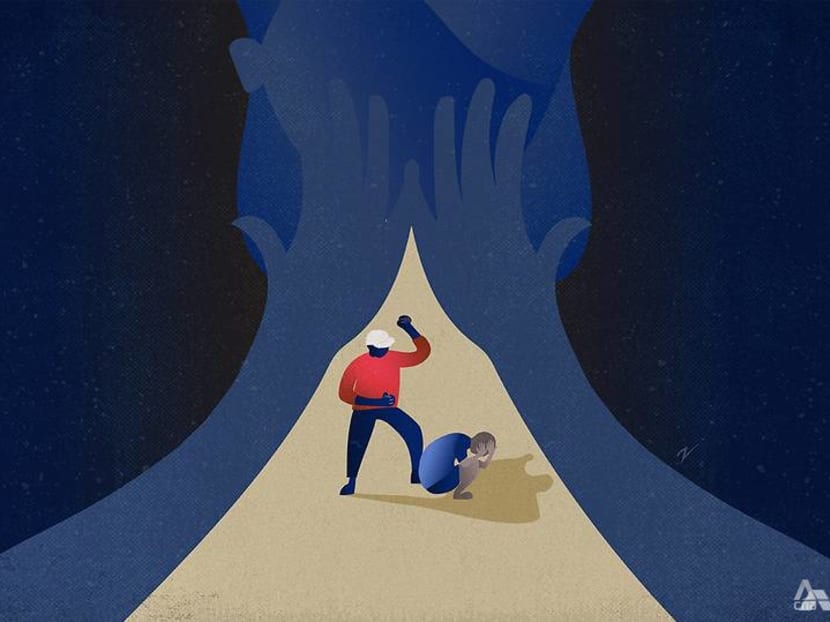Is your child a bully? How parents can spot the signs and what they should do
What causes bullying and just how much of it is the fault of parents? Experts highlight certain behaviours to look out for – and how one should approach the issue at home.

(Art: Chern Ling)
The recent case of bullying at Mee Toh School about a Primary 5 student being picked on by her peers drew widespread attention on social media. And as the public expressed their sympathy for the victim and apologies were issued, other questions emerged regarding the reported victimisers – and the very act of parenting.
“What leads to these kinds of unfortunate situations?”, “Are their parents checking up on them?”, “How could they let their child behave so badly?”
But sometimes, bullying behaviour might not be immediately noticeable to parents, who might actually be clueless about what their kid’s been doing outside of home.
So CNA Lifestyle spoke to some experts to find out more: What causes bullying, what are the signs to look out for, and what parents can do about it – or about their behaviour.
THE CAUSES OF BULLYING BEHAVIOUR
According to Ann Hui Peng, Group Lead of Children Development and Director of Student Services at the Singapore Children’s Society, several overseas research findings have found that children with parents who use harsh parenting styles are more likely to be involved in bullying. These children can be the bullies or the victims, or both the bully and the victim.
However, she noted that the findings were not conclusive proof of causation between parenting and bullying.
Ann added that other research have shown that the presence of parent-child conflict is more likely to lead to a child bullying others.
Additionally, having a secure parent-child relationship is an important protective factor for children. Children with a secure parent-child relationship are better at managing conflicts in social relationships and are able to seek help from their parents at the early signs of distress, which can help prevent them from bullying others.
The presence of parent-child conflict is more likely to lead to a child bullying others.
Children who bully others might also use it as a way to establish dominance and status within a peer group, said Dr Cheung Hoi Shan, Assistant Professor of Psychology at Yale-NUS College.
The use of aggression and the intention to hurt can be strategic, with the goal of gaining access to resources such as toys – seen in younger children – or in the case of adolescents, attention from the opposite gender.
Dr Cheung also agreed with the importance of a secure parent-child relationship, noting that the affectional bond between parent and child can promote the development of empathy and emotional control among children.
She explained: “A strong parent-child relationship also facilitates better communication, which makes it easier for parents to instil positive values, and to identify and rectify behavioural problems outside of the home context.”
A FESTERING PROBLEM
In dealing with bullying behaviour, parents should not leave the problem alone and hope your child grows out of it.
“The worst action possible from parents with children involved in bullying is to downplay or put a blind eye in addressing the issue,” said Ann.
According to Ann, unchecked bullying may lead your child to normalise the behaviour and adopt them in adulthood.
“Some of these children may erroneously learn that being aggressive is the way to go about getting what they want, or it is acceptable to be disrespectful and hurtful to others,” she explained.
Bullies tend to be less well-liked by their peers, which negatively affects the bullies’ own mental health.
The behaviour may be detrimental enough to cause children to grow up with poor social skills, which may lead to aggression in adulthood and even criminal activity.
Besides this, bullying behaviour also has a strong negative impact on the bullies themselves.
Dr Cheung said: “Much as bullies are often successful in establishing dominance in the peer group, they also tend to be less well-liked by their peers, which negatively affects the bullies’ own mental health.”
KNOWING THE KEY INDICATORS
According to Dr Cheung, it is actually common for parents not to know if their child has been bullying others in school.
This finding was the result of a study done on bullying by Dr Cheung and her research laboratory, which involved parents and children between the ages of 10 and 12. The study found that parents and children had vastly different reported experiences with bullying.
And because bullies and parents might not be on the same wavelength, this results in the child being left unsupported at home, which increases the risk of him or her exhibiting even more anti-social behaviour.
When taking steps to find out whether your child is a bully, parents should be aware of their own observations or reports from others about their child and use the information to investigate further if they notice additional signs their child might exhibit, said Ann.
Behavioural indicators include lack of self-control, aggressive language and showing a lack of empathy
She listed down several behaviours parents could look out for, such as their child having a poor relationship with teachers, family and schoolmates, as well as affiliating with antisocial peers.
Other possible behavioural indicators include impulsive behaviour showing a lack of self-control, use of aggressive language and violent behaviours, and showing a lack of empathy towards others.
However, Ann stressed that these are not absolute indicators to identify if your child is a bully.
“Open communication and close monitoring are necessary to confirm your suspicion,” she explained.
Parents should also address their concerns in a calm and objective manner, and not disregard other parents’ observations of your child.
“Share some of your suspicions with the school teachers and ask for close monitoring,” Ann added. “Do subtle checkouts with your child by asking about their activities with their peers.”
ADDRESSING YOUR CHILD’S BEHAVIOUR
In the event that your child is indeed bullying others, Ann said that it is important to “stay calm and composed” and not to let any negative emotions cloud your judgment and subsequent actions.
She said: “Children will make mistakes in their lives and that’s where the parenting role comes in. Go in with a positive mindset that you are going to support your child and help correct his or her behaviours.”
She listed several steps on how to deal with bullying behaviour, beginning with understanding the situation from your child as well as his or her teachers. She added that parents should keep in mind that their child may try to defend themselves by denying or minimising any wrongdoing.
Children will make mistakes in their lives and that’s where the parenting role comes in.
To deal with this, Ann suggested encouraging your child to own up by reassuring and supporting your child to become a better person. Parents should also make it clear that bullying will not be tolerated, and to discuss the negative effects that it has on victims.
In some cases, children may consider their behaviour as being playful or just pranking their friends, in which case parents should discuss with their child that what they consider as playful behaviour has, in fact, hurt somebody.
In order to hold their children accountable and to let them know that bullying others is unacceptable, Ann said that parents could implement consequences for their actions such as removing certain privileges or giving them reflection time to think about what they have done.
Parents could also increase supervision of their child’s activities and whereabouts, and who he or she is associating with. Ann also advised parents to spend time with their child, and set reasonable rules for his or her activities and curfews.
WHY TALKING TO THE SCHOOL IS IMPORTANT
Co-operation with your child’s school is also important. Ann said: “Frequent communication with teachers or administrators is important to find out how your child is doing in changing his or her behaviour.”
While being strict is important, it is also equally beneficial to display positive reinforcement and to set a good example for your children, said Ann.
Pay attention to other good behaviours in your child. Help your child realise that he or she is not bad at all.
“Parents can praise the efforts your child makes towards non-violent and responsible behaviour, as well as for following home and school rules,” she elaborated. “Pay attention to other good behaviours in your child and encourage more of those. Help your child realise that he or she is not bad at all.”
She added: “Be a good model of non-harmful behaviour to others. Children learn a lot from observing their parents.”
Ann also cautioned that bullying behaviour can arise from external influences. Violent videos and games, Tik Tok pranks, exposure to family violence may also trigger your child to engage in undesirable behaviour.
Parents of bullies are also advised to communicate with the parents of the victim with the intention of restoring relations and to apologise.
Ann said: “When parents communicate in a respectful manner, they are modelling positive conflict resolution skills for their children.”





